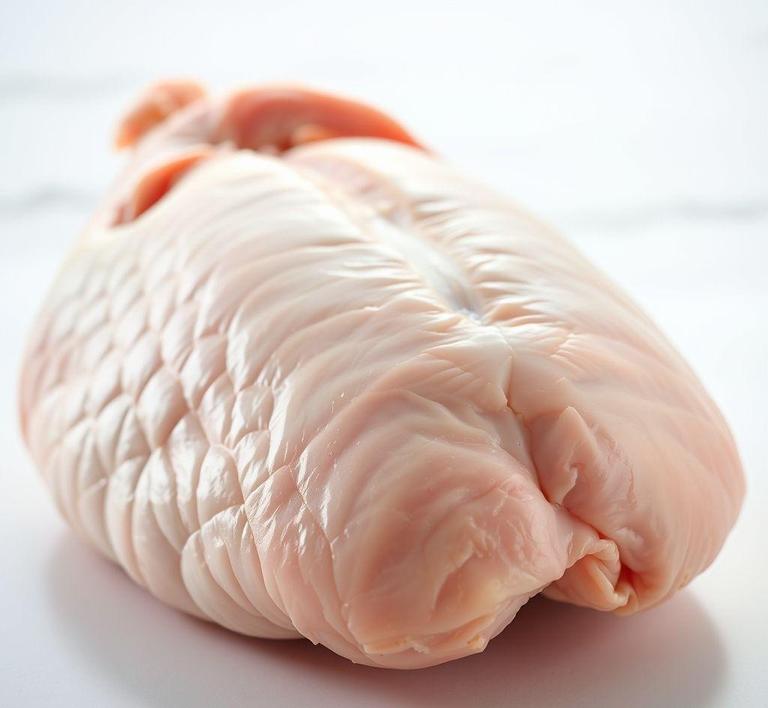If you’ve ever found yourself with extra uncooked turkey breast that you’re not quite sure what to do with, you’re not alone! The good news is, you can safely refreeze uncooked turkey breast as long as it’s been properly thawed in the fridge and hasn’t been left at room temperature for too long. Refreezing turkey can help save you from wasting food and ensures you have some extra poultry ready for your next meal. But, there are a few key steps and considerations to keep in mind to ensure the turkey remains fresh and safe to eat. In this guide, we’ll walk you through everything you need to know about how to refreeze uncooked turkey breast and some important tips to keep in mind along the way.
Can You Refreeze Uncooked Turkey Breast?

Yes, you can refreeze uncooked turkey breast, but there are important conditions that must be met to do so safely. The primary concern with refreezing any meat, including turkey, is the potential growth of harmful bacteria when the meat is in the "danger zone" of temperatures – between 40°F and 140°F (4°C and 60°C). If your turkey breast has been thawed properly – that is, in the refrigerator and not at room temperature or in warm water – then it is safe to refreeze.
However, if the turkey has been left out at room temperature for more than 2 hours (or 1 hour in temperatures above 90°F/32°C), refreezing is strongly discouraged. This is because bacteria such as Salmonella or Campylobacter may have begun to multiply, and freezing does not kill these pathogens – it only halts their growth temporarily.
So, the key takeaway is this: only turkey breast that has been thawed safely in the refrigerator and has not exceeded safe handling times can be refrozen.
How To Refreeze Uncooked Turkey Breast?
Refreezing turkey breast isn’t just a matter of tossing it back into the freezer – it should be done with care to maintain as much of the original quality and safety as possible.
Here’s a step-by-step guide to properly refreeze uncooked turkey breast:
-
Assess Safety:
• Check how the turkey breast was thawed. If it was thawed in the refrigerator and kept under 40°F (4°C), it’s likely safe to refreeze.
• If it was thawed using the cold water method or microwave, it must be cooked before refreezing.
-
Portion Wisely:
• Divide the turkey breast into smaller, usable portions before freezing. This reduces waste and makes future thawing more convenient.
-
Pat Dry:
• Blot the surface of the turkey breast dry with a paper towel. Excess moisture can contribute to freezer burn and degrade the texture.
-
Package Properly:
• Wrap the turkey breast tightly in plastic wrap or freezer paper, and then place it inside a heavy-duty freezer bag or airtight container.
• Squeeze out as much air as possible to minimize freezer burn and oxidation.
-
Label and Date:
• Clearly label the package with the current date and contents so you can keep track of how long it’s been stored.
-
Freeze Quickly:
• Place the turkey breast in the coldest part of the freezer – ideally at 0°F (-18°C) or lower – to minimize ice crystal formation, which can damage the meat’s texture.
Quality Impact
While refreezing turkey breast is safe when done properly, the process can negatively affect its quality. Here’s what typically happens:
-
Moisture Loss:
• During the thawing process, cell walls in the turkey breast rupture, leading to moisture loss. When refrozen and thawed again, this water loss can become more pronounced, resulting in drier, less juicy meat once cooked.
-
Texture Changes:
• The freezing and thawing cycles can cause structural breakdown in muscle fibers. This often leads to a slightly mushy or spongy texture compared to never-frozen turkey breast.
-
Flavor Degradation:
• Oxidation and freezer burn – particularly if packaging isn’t airtight – can result in off-flavors that dull the natural taste of the meat.
-
Nutritional Impact:
• There is minimal loss of nutrients, but repeated freezing and thawing can cause minor declines in certain water-soluble vitamins, like B-complex vitamins.
In culinary terms, you may find the refrozen turkey breast less ideal for grilling or roasting where texture matters, but it will still perform well in soups, stews, or casseroles where the meat is shredded or cooked in liquid.
Refreezing uncooked turkey breast is indeed possible – and safe – if handled correctly. The key is ensuring that the meat has remained at a safe temperature (below 40°F) and hasn’t been exposed to bacterial growth conditions. The process of refreezing may slightly impact texture and moisture levels, but the turkey remains suitable for a wide variety of dishes.
If quality is your top priority, try to plan ahead and only thaw what you need. But if life happens – as it often does – and you need to refreeze, rest assured: with proper technique and care, your turkey breast won’t go to waste. Just be mindful of storage practices, monitor for freezer burn, and consider using the refrozen turkey in recipes that compensate for any texture changes.
Is It Safe To Refreeze Uncooked Turkey Breast?
Refreezing uncooked turkey breast is a topic that stirs up a fair amount of confusion and concern-understandably so. Raw poultry is highly perishable and susceptible to bacterial contamination if not handled properly. However, under the right circumstances, it is indeed safe to refreeze uncooked turkey breast.
The key condition for safely refreezing is this: the turkey must have been thawed in the refrigerator and must have remained at a consistent temperature below 40°F (4°C). If these conditions were met, and the meat shows no signs of spoilage, it can be safely returned to the freezer.
It’s important to note that while refreezing is safe under these parameters, it may come at the cost of quality. Turkey breast that has been thawed and refrozen tends to lose moisture and texture. The result may be a drier, slightly less tender cut once cooked. This happens because water within the muscle fibers forms ice crystals during freezing, which rupture cell walls. Repeating this process can exacerbate the damage, especially in lean meats like turkey breast.
However, if you’re planning to use the refrozen turkey in a stew, soup, or dish that incorporates moisture and seasonings, the textural compromise might not even be noticeable.
Signs That Uncooked Turkey Breast Should Not Be Refrozen
Even if the turkey has been thawed in the fridge, it isn’t always a candidate for a safe refreeze. There are a few unmistakable signs that it’s better to discard rather than refreeze:
-
Off Smell:
A sour, sulfur-like, or generally foul odor is a sure indicator that bacteria have taken hold. Fresh raw turkey has a very mild, almost imperceptible scent. Any pungent smell is a red flag.
-
Slimy or Sticky Texture:
A slick, sticky, or tacky surface suggests bacterial activity. Turkey should feel slightly moist but not slippery.
-
Discoloration:
While slight changes in color (from pink to a light grayish hue) may be due to oxidation, greenish, dull, or dark gray tones signal spoilage.
-
Temperature Exposure:
If the turkey breast has been left at room temperature for more than 2 hours (or more than 1 hour in temperatures above 90°F/32°C), it should not be refrozen or consumed. The "danger zone" (40-140°F / 4-60°C) is the range in which harmful bacteria thrive.
-
Unknown Thawing Method:
If the turkey was thawed using methods like soaking in warm water or being left out on the counter, its safety is compromised. These methods encourage rapid bacterial growth and rule out any chance of refreezing.
Common Refreezing Mistakes
Refreezing raw turkey breast may sound simple, but it’s easy to misstep. Here are the most common mistakes people make-and how to avoid them:
❌ Thawing at Room Temperature:
Leaving turkey to thaw on the countertop is a major no-no. Even if the center remains icy, the outer layers quickly enter the danger zone, becoming a breeding ground for bacteria.
❌ Refreezing After Partial Thawing in the Microwave:
Microwave defrosting can cause uneven thawing, partially cooking some areas while leaving others frozen. This partial cooking initiates bacterial growth, and refreezing it afterward can increase foodborne illness risks.
❌ Repeated Freeze-Thaw Cycles:
Constantly thawing and refreezing turkey, even under safe conditions, degrades both quality and safety. Plan ahead to only thaw what you intend to use.
❌ Not Labeling Packages:
Without proper labeling, you may not remember how long the turkey has been in the freezer or whether it’s been previously thawed. Always label with the date of freezing (and refreezing, if applicable).
Tips And Tricks
Want to ensure you handle turkey breast safely and preserve as much flavor and texture as possible? Here are some expert tips:
✅ Portion Before Freezing:
Divide turkey breast into individual meal-sized portions before freezing. This minimizes waste and eliminates the need to thaw and refreeze large amounts.
✅ Freeze in Vacuum-Sealed Bags or Freezer Wrap:
Reduce freezer burn and dehydration by wrapping turkey tightly with freezer-safe packaging. Vacuum-sealing is ideal, but pressing out as much air as possible from a zip-top freezer bag works too.
✅ Label Clearly:
Include the original freeze date and any refreeze date. Most turkey can be safely frozen for up to 9 months. After that, while it may still be safe, the quality begins to diminish.
✅ Thaw Slowly in the Refrigerator:
This is the safest and most controlled method. It takes longer-typically a day or more, depending on the size of the breast-but it ensures the meat stays out of the danger zone.
✅ Cook Immediately After Final Thaw:
Once you’ve thawed a turkey breast for the second time (after refreezing it once), be sure to cook it immediately. Don’t attempt to refreeze again-it’s a one-time deal.
Conclusion
Refreezing uncooked turkey breast is not just possible-it can be done safely with the right knowledge and practices. The cardinal rule is all about temperature: if the meat has been thawed safely in the refrigerator and hasn’t exceeded the 40°F threshold, you’re likely in the clear to refreeze. But never ignore signs of spoilage or improper thawing, as food safety should always trump the desire to salvage meat.
By avoiding common mistakes, recognizing spoilage indicators, and following proven handling techniques, you can reduce waste without risking your health. Whether you’re meal prepping, navigating the aftermath of a big grocery haul, or simply changing dinner plans last-minute, understanding how to safely refreeze turkey breast equips you to be both resourceful and food safe.


